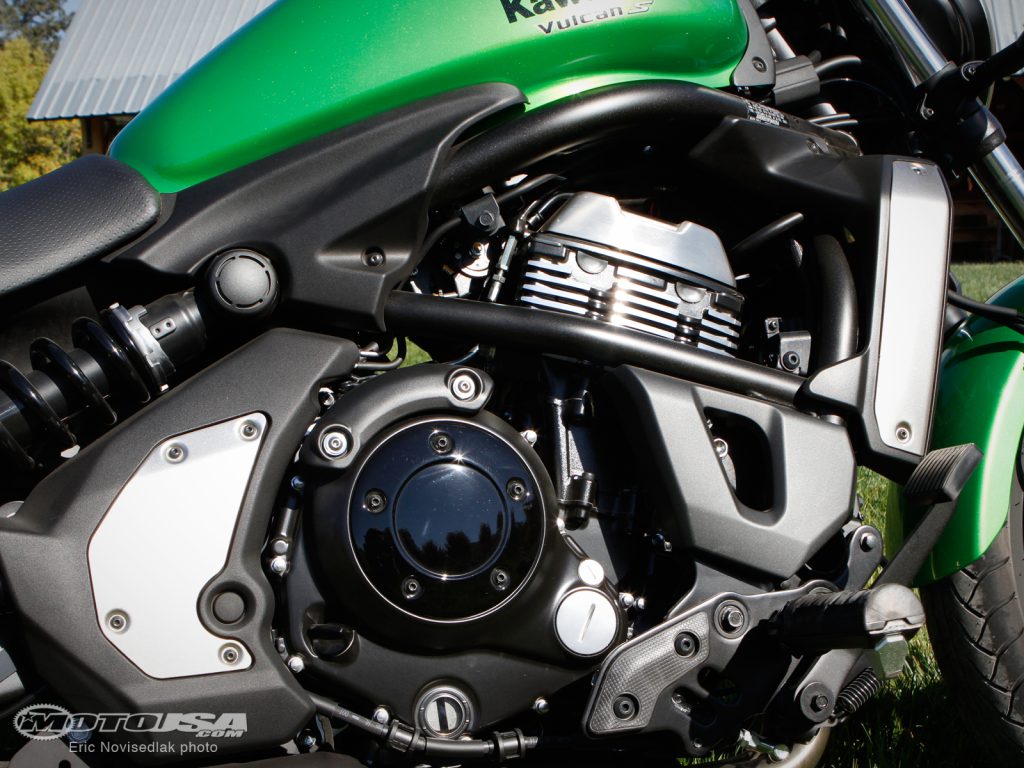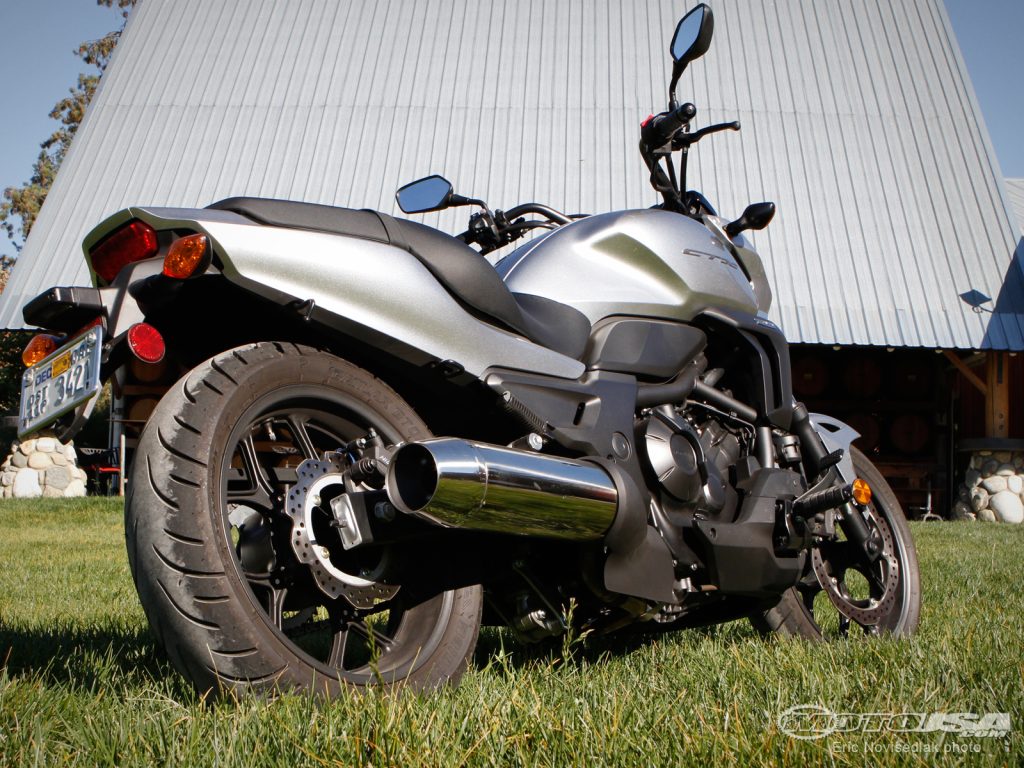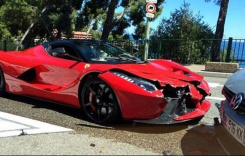Honda and Kawasaki have both taken an unconventional approach to the mid-level “cruiser” market with the 2015 CTX700N and Vulcan S. Stylistically, both bikes teeter more toward the sport/standard side of the equation. The tried-and-true V-Twin formula that exemplifies the US cruiser market has been abandoned in favor of Parallel Twins. The primary cruiser carry-over is an upright riding position and punched-out controls. And though the two motorcycles blur the lines of categorization, they both are fighting for sales in the same demographic and share enough similarities MotoUSA matched them in a head-to-head comparison.
In the engine department, both utilize liquid-cooled Parallel Twins, the 670cc engine of the CTX700N with a slight displacement advantage over the 649cc mill of the Vulcan S. Honda went the undersquare route with a 73mm bore and 80mm stroke while Kawasaki went oversquare using a larger 83mm bore and more compact 60mm stroke. This makes for distinctively different engine characteristics, which we’ll touch on soon. Compression ratios are almost identical, the Honda sporting a 10.7:1 ratio to the Kawasaki’s 10.8:1. Both motorcycles source a six-speed gearbox and utilize a chain final drive. Suspension arrangements are similar, each equipped with a 41mm fork and single rear shock. The Vulcan S runs an inch larger wheel up front at 18 inches, but both use a 160/60-17 arrangement on the rear.

Out on the road we enjoyed the surge of power delivered with the first crack of the Honda’s throttle, and off the line the CTX has an edge on the Vulcan. Throttle response is immediate and gratifying, as fueling on the CTX700N is crisper and cleaner than the Kawasaki’s more abrupt throttle response and choppier fuel delivery. A trip on the MotoUSA dyno confirmed our seat-of-the-pants assumptions. The 2015 CTX700N delivers 40 lb-ft of torque at 2900 rpm and stays in that range until 5400 rpm, peaking at 41.19 lb-ft @ 4200 rpm. The Honda’s powerplant reaches its peak 43.04 hp @ 6100 rpm on its way to its 6600 rpm ceiling.
The Kawasaki Twin generates a higher peak torque output of 42.43 lb-ft @ 5700 rpm, but it doesn’t match the CTX on the bottom end. The Vulcan doesn’t hit the 40 lb-ft of torque range until 4800 rpm, however, the 649cc Kawasaki engine revs much higher than its Honda rival. The result is loads more horsepower, topping out at 55.9 hp @ 7500 rpm on its way to a 9300 rpm redline. Top end is where Kawasaki’s decision to go with an oversquare design pays dividends because long after the CTX700X taps out, the Vulcan S is still revving.
The CTX700N is fine as long as you keep it in its happy place in the low- to midranges, but it hits the rev limiter way earlier, so you’re shifting a lot more so than on the Kawasaki. In sixth gear on the Honda there’s a lack of roll-on too, and if you’re on a freeway with a 75 mph speed limit, you’ll be gritting you’re teeth getting by semis while it slowly builds up steam. Conversely, the Vulcan S provides plenty of passing power, even in the higher rpm range of fifth and sixth gear.

“The CTX700N engine has a nice amount of pull at the initial application, noticeably snappier than the Vulcan S. The rev range is limited to maintain that pull though, and drop off is dramatic before reaching the red line, which comes quickly. First gear seems to cut out far too soon, and power shuts down abruptly if you tip the needle past the rev limit. In practice I found myself keeping the CTX a gear higher than the Vulcan S at similar speeds to ensure there was something available when I needed to pass,” said MotoUSA Associate Editor and fellow test rider Byron Wilson.
Since you’ll be running through gears more frequently on the Honda, it’s fortunate the CTX700 gearbox shifts smoothly and lever pull is light. Gears fall into place quietly with little fuss. On the Vulcan S, the transmission’s gear ratios allow riders to get the most out of every shift, but engagement isn’t as clean as the Honda’s. We did appreciate that sixth on the Vulcan S is more potent than sixth on the CTX700, which acts primarily as an overdrive.
One of the reasons for this is the CTX700N’s fork being set at a sportier rake angle of 27.7 degrees compared to the Vulcan S setting of 31 degrees. The CTX700N is also slightly more compact than the Kawasaki, its 60.2-inch wheelbase 1.8-inches shorter than the Vulcan S. The Honda is16.5 pounds lighter as well, tipping our scales with a curb weight of 483 pounds. Another barometer that tips the handling equation in favor of the Honda is both Wilson and I found the suspension on the CTX700N to be the better sorted of the two.
“Suspension-wise, the CTX700N felt plusher than the Vulcan S. It soaked up bumps well at lower speeds and is surprisingly adept in the twisties. It holds its line well and really encourages the rider to lean a bit more and carry more speed through the next corner. It carries its weight low and takes only the slightest input to dip into turns,” said Wilson.
That said, the fork on the CTX700N is soft, most noticeably at higher speeds. The Pro-Link shock on the rear is sprung better and soaks up bumps well as it has a 1.1-inch advantage in travel compared to the Vulcan S. With a 225-pound rider onboard, the Kawasaki’s single Kayaba laydown shock is frequently taxed to the limits of its range.
While the Vulcan S gets the nod in the ergonomics department, it also ranks tops in the braking category. With a 300mm front rotor paired to twin-piston Nissin calipers, stopping power is strong and even. The unit provides plenty of feel at the lever although the initial bite into the rotor is moderate. The single 250mm rear is equipped with a single-piston Nissin caliper but has the benefit of Bosch 9.1M ABS. The anti-lock brakes on the Vulcan S aren’t overly intrusive and the pulse isn’t overbearing.
The CTX700N has a single 320mm disc with a two-piston caliper on the front and a 240mm rotor on the rear, also equipped with a single-piston caliper. While both braking packages are capable, the combo on the Vulcan S is more powerful. Granted, we did test the Vulcan S with the ABS package, which definitely helps. Both motorcycles are available with or without ABS, but adding it to the Vulcan S tacks on only $400 to the base $6999 MSRP while it costs $600 to add it to the CTX700N with the same $6999 sticker price for the base model. To our knowledge though, Honda only offers ABS for the CTX700N with the Dual-Clutch Transmission, so to get ABS you have to pay more and get an automatic transmission.

A major factor in the cruiser niche is curb appeal. Of course, styling is arbitrary, but how a motorcycle looks is the first thing that often strikes an emotional chord in potential buyers, particular cruiser guys. On the Honda there’s plenty of plastic, from its bodywork to its tank shrouds. Its pipe is large and non-descript but puts out a decent note. The CTX700N has a big, visible digital display tucked into the housing above the headlight, large numbers dominating the speedometer readout, a tachometer bar running across the top, fuel bars to the right.

With less bodywork, the Vulcan S leaves less to the imagination as the architecture of its steel-tubed perimeter frame and Parallel Twin are more on display. The bobbed cut to the back fender is an attractive feature, but the bulky plastic housing for the taillight, blinkers and license plate cuts into the cool factor. The instrument display on the Vulcan S is smaller, a round gauge with a digitized readout for speed, a fuel gauge below that. Its tachometer is the prominent feature here, an analog needle bouncing up its face as riders run through the Vulcan S’s greater rpm range. As mentioned, looks are in the eye of the beholder, but by far we got more thumbs up on the Vulcan S from random people than the Honda.
One last item of note is efficiency. The CTX700N is a real gas-sipper, getting an impressive 59.7 miles-per-gallon. The Vulcan S, while efficient, averaged 43.1 mpg over the course of our testing. Seeing how the Vulcan S has the larger tank of the two, 3.7 gallons to 3.17, fuel stops for the two felt about the same, but range projections for total miles favor the CTX by about 30 miles.

That said, which is the better bike in this comparison? It’s a tough call because each has its merits. The Honda is refined and easy to ride. It ticks the boxes for having the smoothest transmission, lighter handling, more dialed-in suspension and being the most fuel efficient. The Kawasaki has a revvier, more potent powerplant, stronger brakes, doesn’t get buffeted around as much on the freeway and is more all-day comfortable. But the disparity between the two in the transmission, handling and suspension departments aren’t that great, and we’d rather have a motorcycle that requires less shifting and more passing power on the highway, so both Wilson and I agree that given the choice we’d jump in the saddle of the Vulcan S first









